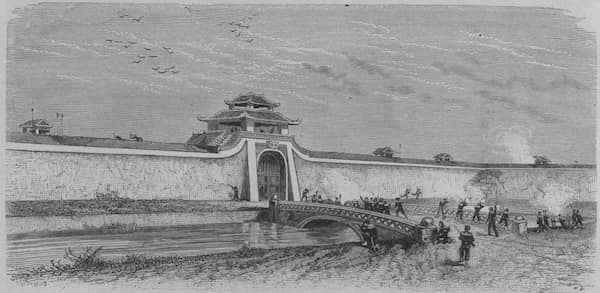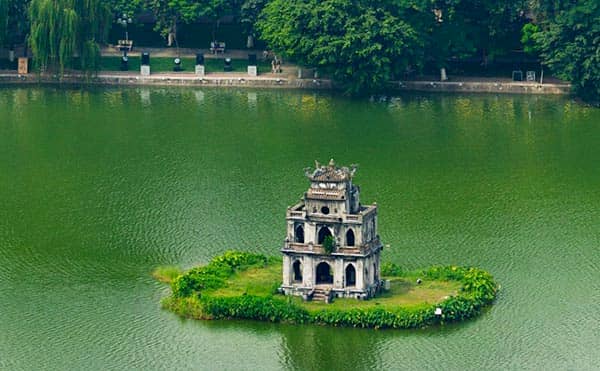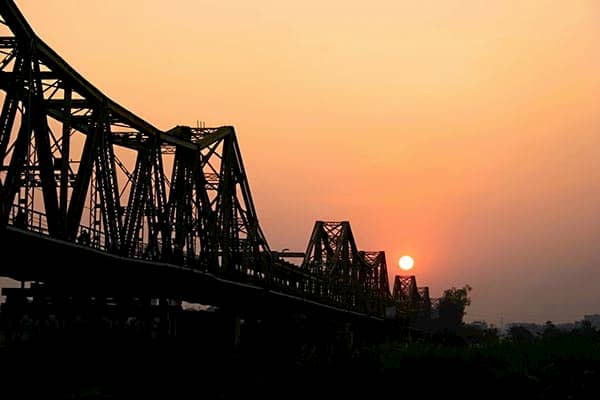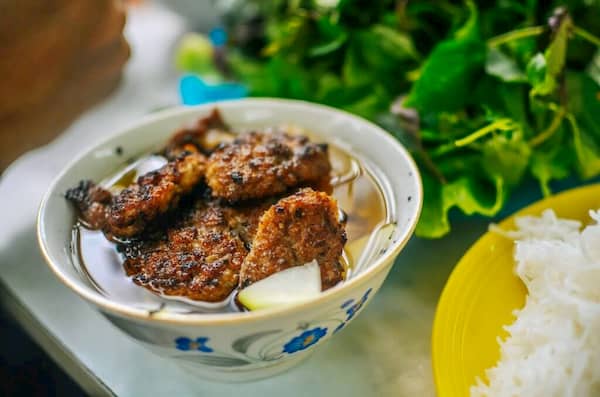HANOI - NORTHERN VIETNAM
A UNIQUE CAPITAL OF ITS KIND, WITH INFINITE ASSETS
Hanoi is the capital - Political, educational, economic and cultural centre of Vietnam. It is located on the banks of the Red River Delta in northern Vietnam and is the second most populated city in the country. In Vietnamese, the name of the city is composed of "Ha" (river) and "Noi" (between). Hanoi therefore means "the city between the rivers".
Thanks to its many assets and its different facets, Hanoi is a real must for your trip to Vietnam.
History of Hanoi
In 1010, King Ly Thai To ordered the transfer of the capital from Hoa Lu to Hanoi. At that time, Hanoi was called "Dai La". However, according to legend, the king saw a dragon flying away when he arrived at the citadel of Dai La, which was then renamed "Thang Long" (the dragon taking flight). Ly Thai To chose this location to develop the country's political, cultural and economic centre because the land was considered very favourable. The citadel consisted of three walls.
The Ly dynasty was also at the origin of the creation of the Temple of Literature (1070), the School of the Crown Prince (future Quoc Tu Giam, first national university) and the era of Dai Viet civilization.
Later, the Tran dynasty retained Thang Long as its national capital and restored it after it was damaged in fighting at the end of the Ly dynasty. The Tran dynasty is also at the origin of martial arts schools. Military science was an important part of Dai Viet's culture. Under the Tran dynasty, Thang Long continued to develop rapidly and experienced significant population growth, while many foreign traders came to do business there.
In 1397, Ho Quy Ly took power and changed the name of the capital to "Dong Do" (Eastern capital). He also created "Tay Do" (Western capital). For a while, the country had two capitals.
The capital later became unique again and took the name of Thang Long. Despite all these historical upheavals, Thang Long never stopped developing and the population was constantly increasing.

Drawing of the citadel of Hanoi in the 19th century
The name of the capital changed again to Bac Thanh ("citadel of the north") under the Nguyen dynasty. The name Hanoi was adopted in 1831 under the reign of Minh Mang.
The people of Hanoi and the whole country rose up at the end of the 19th century against the French invaders. However, in 1883, the Nguyen Court signed a peace treaty recognizing French domination in the country. The arrival of the French at the head of the country marked the creation of communication networks but also road networks, one of the most famous being the Paul Doumer Bridge (now Long Bien Bridge). Many other constructions were undertaken and the French/European style is still visible in the capital today.
The year 1954 marks the liberation of Hanoi. The face of the capital was constantly changing. Then the city was hit by the Vietnam War and will be the target of several bombings by the Americans. The war ended in 1975, and in 1976 Hanoi was chosen as the capital of the Socialist Republic of Vietnam.
Hanoi has therefore undergone many changes since its inception. Each period transformed the city and left traces that are still visible today.
What to do in Hanoi?
Lake Hoan Kiem
Lake Hoan Kiem (Restored Sword lake) is a true symbol of the capital. This lake is in the heart of a famous legend. According to her, the Emperor The Law would have received from a fisherman a sword caught in this lake. He then used this sword to fight against the Chinese invaders. Once his mission was accomplished, he was reportedly approached by a turtle as he crossed the lake. In the name of the Dragon King, the turtle reportedly asked The Law to return the sword to him. The latter would then have understood that the sword was a divine gift to repel the invaders and returned it to the turtle.
On this lake you can find a red bridge (illuminated in the evenings) that leads to Jade Island and its Ngoc Son temple, which houses two giant mummified turtles that once lived in the lake.

Sword Lake in the heart of Hanoi
The old quarter
Hanoi's old quarter is a must when visiting the city. It is a historic district where merchants and craftsmen met daily. It is sometimes called the "district of 36 corporations". Today it has 76 of them and a good part of them have kept their original name, which represents the goods that can be found there. Thus, in this old district, it is possible to walk in the street of shoes, the street of sugar, the street of leather, the street of cotton, the street of tinsmiths,...
You can also admire the many pipe houses in the neighbourhood, symbols of daily life in Vietnam.
Within the old quarter there are also many temples and pagodas. One example is Bach Ma's temple. This is a temple that was built to honour a white horse that appeared in King Ly Thai Tô's dream to indicate the site where the new Thang Long Citadel was to be built.
The surroundings of Lake Hoan Kiem are also a highlight of the old quarter. At weekends, the streets around the lake are entirely pedestrian, which allows you to stroll around while enjoying the entertainment, local activities and the night market.
Visiting the old quarter of Hanoi is therefore essential during your trip to Vietnam, both to buy various goods and to simply dive into the heart of Vietnamese daily life and taste many local specialities in an extremely lively atmosphere.
The French Quarter
The French Quarter in Hanoi was in contrast to the rest of the city at the time, mainly because of the large villas that were present there. These villas still exist today in this district, which is one of the most famous in the capital.
The district is also famous for the Ho Chi Minh Mausoleum, which houses the remains of Ho Chi Minh, the founder of the Democratic Republic of Vietnam. The Mausoleum is 41.2 m long and 21.6 m high and is made mainly of granite. It is open to the public.
The Museum of Ethnology
The Museum of Ethnology is a perfect place to learn more about the daily lives of the 54 ethnic groups in Vietnam. Indeed, there are more than 15,000 objects, 42,000 films with colour images, audio cassettes,... All the exhibits are classified according to different criteria such as ethnic origin, function, type,... All the information given by the exhibition is available in Vietnamese, English and French. Divided into 3 parts, this museum is undeniably one of the most beautiful in the country, so don't miss it on your trip to Vietnam.
The Western Lake
This lake is the largest lake in Hanoi with more than 500 hectares of water. Around this lake are also many historical and cultural sites, including the Tran Quoc Pagoda. It is the oldest pagoda in the capital (6th century). In addition, near this lake is the flower market where it is possible to find many different kinds of flowers, which gives rise to sublime mixtures of colours and smells.

The old bridge Long Bien
The Long Bien Bridge
This bridge is a metal structure built in the Eiffel style that allows the North-South Railway to cross the Red River. It is a cantilevered girder bridge with a length of 1,682 m.
The bridge was first called "Pont Paul Doumer" because it was built during the French Indochina period when Paul Doumer was its governor. He then named "Bridge of the Cai River" before being definitively renamed "Long Biên Bridge" during the Second World War.
Gastronomy
in Hanoi
Finally, it is possible to taste in Hanoi many local and northern Vietnamese specialities but also those of the country in general. There are many restaurants, but street food is also a key element in the daily life of the inhabitants and will allow you to discover incredible dishes while soaking up the local culture and sharing a moment with locals. Here are some examples of specialities that you can taste in the capital:
- Pho (rice noodle soup with beef broth, herbs and a combination of several spices)
- Banh
cuon (Vietnamese ravioli with cooked rice sheets, stuffing with ground pork and
black mushrooms)
- Bun
thang (rice vermicelli soup with chicken, pork, shrimp, omelette, salad and
garnish)
- Bun
cha (rice vermicelli with grilled pork, salad, spices and various aromatic
herbs)
- Banh mi (sandwich with a Vietnamese baguette inspired by the French baguette, in which you can put different meats, fried eggs, raw vegetables),...

Specialty of Hanoi: Bun cha
Some tips during your stay in Hanoi
- If you have free time in Hanoi, do not hesitate to walk freely without a specific destination. You will thus meet many locals who will not hesitate to greet you, but also restaurants, parks, religious sites,... A total immersion during your trip to Northern Vietnam.
- Go to the train street (Tran Phu) to observe this train which passes through narrow streets past houses. Show guaranteed!
-
Coffee lovers? Feel free to taste the famous local egg coffee. Although it may
seem strange to Westerners, this recipe for coffee mixed with milk and egg
yolks is excellent and very famous. Don't miss this opportunity!



